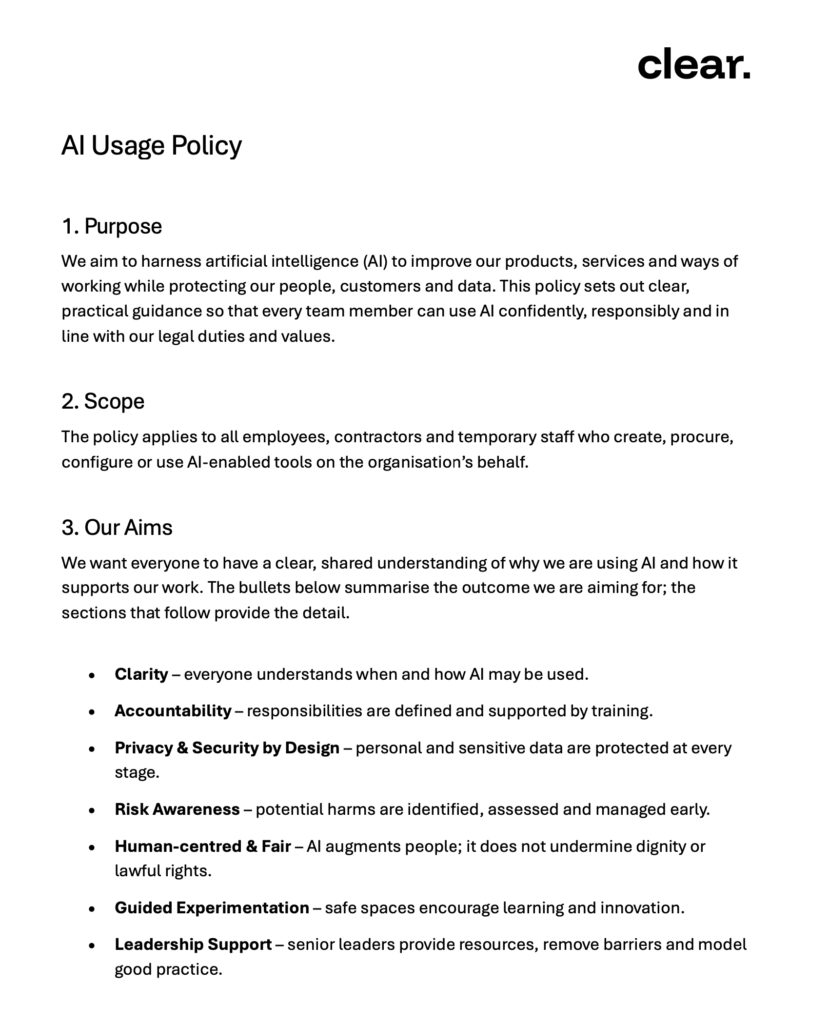The question isn’t whether AI will transform your business—it’s whether you’ll control that transformation or let it control you. As artificial intelligence rapidly moves from experimental novelty to business necessity, organisations worldwide are grappling with a critical challenge: how to harness AI’s potential without losing sight of governance, compliance, and strategic direction.
If you’re asking whether you need an AI Management System (AIMS), you’re likely already experiencing the growing pains that signal it’s time for a more systematic approach to AI adoption.
The hidden costs of unmanaged AI
Many organisations begin their AI journey organically—teams discover useful tools, productivity improves, and leadership encourages experimentation. This grassroots adoption feels positive initially, but it quickly reveals significant hidden costs that compound over time.
Shadow AI proliferation
Without centralised oversight, teams across your organisation are likely using dozens of different AI tools, often without IT knowledge or approval. Marketing might be using one AI writing assistant, sales another, whilst development teams experiment with code generation tools. Each subscription represents not just direct costs, but also data security risks, integration challenges, and duplicated functionality.
Research suggests that mid-sized companies typically have 3-5 times more AI tools in use than leadership realises, with costs and risks accumulating invisibly across departments.
Compliance blind spots
Every AI tool your organisation uses processes data, makes decisions, or influences outcomes in ways that may have regulatory implications. GDPR, industry-specific regulations, and emerging AI legislation create compliance requirements that most teams aren’t equipped to navigate alone.
The challenge isn’t just current compliance—it’s preparing for rapidly evolving regulations. The EU AI Act, UK AI regulation, and other emerging frameworks will require organisations to demonstrate systematic AI governance. Reactive compliance is both expensive and risky.
Knowledge silos and duplicated efforts
When teams adopt AI tools independently, valuable learnings remain trapped within departments. The sales team’s successful chatbot implementation could benefit customer service, but without systematic knowledge sharing, each team reinvents solutions that already exist elsewhere in the organisation.
This fragmentation doesn’t just waste resources—it prevents the cross-pollination of ideas that often leads to breakthrough applications.
Inconsistent data practices
Different AI tools often require different data formats, security levels, and integration approaches. Without coordinated data governance, organisations end up with inconsistent practices that create security vulnerabilities and make it difficult to scale successful implementations.
Strategic risks of the status quo
Beyond operational inefficiencies, unmanaged AI adoption creates strategic vulnerabilities that can undermine competitive advantage and organisational resilience.
Missing innovation opportunities
Without systematic evaluation of AI opportunities, organisations typically focus on obvious, low-hanging fruit whilst missing transformative applications. The marketing team might adopt AI writing tools whilst the operations team, unaware of AI’s potential for process optimisation, continues manual approaches that could be revolutionised.
An AIMS provides the framework to identify high-impact opportunities that isolated teams might never discover independently.
Inability to measure ROI
How do you know if your AI investments are paying off? Most organisations can’t answer this question because they lack systematic tracking of AI-related costs, benefits, and performance metrics. Without clear ROI measurement, it becomes impossible to make informed decisions about where to invest further or which initiatives to scale.
Talent and resource misallocation
AI expertise is scarce and expensive. Without coordinated planning, organisations often have their most AI-capable staff working on low-impact projects whilst high-potential initiatives lack the expertise needed for success. An AIMS helps ensure your best resources are allocated to your highest-value opportunities.
Vendor lock-in and integration challenges
Uncoordinated tool adoption often leads to a patchwork of solutions that don’t integrate well, creating dependencies on specific vendors and making it difficult to evolve your AI stack as needs change. This technical debt becomes increasingly expensive to resolve over time.
Regulatory and compliance imperatives
The regulatory landscape for AI is evolving rapidly, and organisations that wait for requirements to become mandatory often find themselves scrambling to achieve compliance retroactively.
Emerging legal requirements
The EU AI Act introduces specific obligations for AI system operators, including risk assessment, documentation, and monitoring requirements. Similar regulations are emerging globally, creating a complex compliance landscape that requires systematic management.
Industry standards and certification
ISO 42001, the international standard for AI management systems, provides a framework for systematic AI governance. Whilst not yet mandatory in most sectors, it’s increasingly becoming a competitive differentiator and may become required for certain contracts or partnerships.
Insurance and liability considerations
As AI becomes more prevalent, insurance providers are beginning to assess AI governance practices when determining coverage and premiums. Organisations with systematic AI management are likely to be viewed as lower risk, potentially reducing insurance costs whilst improving coverage.
Competitive advantages of systematic AI management
Beyond risk mitigation, implementing an AIMS creates tangible competitive advantages that compound over time.
Faster innovation cycles
With proper governance frameworks in place, teams can experiment with AI more quickly and confidently. Clear policies, established data practices, and systematic evaluation processes remove the friction that slows down innovation whilst maintaining appropriate oversight.
Better resource allocation
Systematic tracking of AI initiatives enables data-driven decisions about where to invest resources for maximum impact. Successful pilots can be scaled efficiently, whilst underperforming initiatives can be terminated before consuming significant resources.
Enhanced stakeholder confidence
Customers, partners, and investors increasingly expect organisations to demonstrate responsible AI practices. Systematic AI management provides the transparency and accountability that builds trust and opens doors to new opportunities.
Future-proofing
As AI capabilities continue advancing and regulations continue evolving, organisations with mature AI management systems can adapt more quickly to new requirements and opportunities. This agility becomes increasingly valuable as the pace of change accelerates.
When is the right time to implement an AIMS?
The ideal time to implement an AI Management System is before problems become crises. Several indicators suggest your organisation is ready for systematic AI management:
Scale indicators
- More than three departments using AI tools independently
- AI-related spending exceeding £10,000 annually across the organisation
- Multiple overlapping or competing AI initiatives
Risk indicators
- Uncertainty about current AI tool usage across the organisation
- Compliance concerns or audit findings related to data handling
- Security incidents involving AI tools or data
Opportunity indicators
- Leadership recognition of AI’s strategic potential
- Competitive pressure to accelerate AI adoption
- Customer or partner requests for AI-related capabilities
Organisational readiness
- Executive sponsorship for systematic AI governance
- Available resources for implementation and ongoing management
- Cultural openness to structured approaches and process improvement
The cost of waiting
Delaying implementation of systematic AI management doesn’t eliminate costs—it simply shifts them to the future whilst allowing inefficiencies and risks to compound. Organisations that wait often find themselves facing:
- Higher implementation costs due to technical debt and process complications
- Regulatory compliance gaps that require expensive remediation
- Missed opportunities that competitors have already captured
- Cultural resistance to governance after teams have become accustomed to complete autonomy
Making the business case
The business case for an AI Management System typically rests on three pillars: cost reduction, risk mitigation, and revenue enhancement.
Cost reduction: Eliminating duplicate subscriptions, optimising tool selection, and improving resource allocation typically generates immediate savings that offset implementation costs.
Risk mitigation: Avoiding compliance penalties, security incidents, and strategic missteps provides substantial value that’s difficult to quantify but essential to protect.
Revenue enhancement: Systematic identification and scaling of high-impact AI opportunities often generates revenue improvements that dwarf the investment in management infrastructure.
Most organisations find that the combination of these benefits creates a compelling ROI within the first year of implementation.
Conclusion
The question isn’t whether you need an AI Management System—it’s whether you can afford to continue without one. As AI becomes increasingly central to business operations, systematic management transitions from a competitive advantage to a basic requirement for sustainable success.
The organisations that implement AIMS today will find themselves better positioned to capitalise on AI’s transformative potential whilst avoiding the pitfalls that trap their less-prepared competitors. They’ll also discover that systematic AI management doesn’t constrain innovation—it creates the conditions for innovation to flourish safely and strategically.
Every day without systematic AI management is a day of accumulating technical debt, missed opportunities, and growing risks. The only question is whether you’ll address these challenges proactively or wait until they become crises that demand immediate attention.
Clear is the perfect solution for organisations ready to transform their AI approach from reactive experimentation to strategic advantage.
Unlike enterprise-grade solutions that require extensive implementation and ongoing maintenance, Clear provides comprehensive AI management capabilities designed specifically for mid-market organisations. With transparent pricing , unlimited team members, and expert support included, Clear eliminates the barriers that have traditionally made systematic AI management accessible only to large enterprises.
The platform’s four-phase methodology ensures you’re not just implementing a tool, but building sustainable AI capabilities that scale with your organisation’s growth and prepare you for future compliance requirements like ISO 42001.


